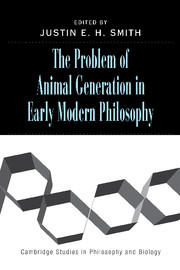Book contents
- Frontmatter
- Contents
- List of Contributors
- Introduction
- I THE DAWNING OF A NEW ERA
- II THE CARTESIAN PROGRAM
- 3 Descartes's Experimental Method and the Generation of Animals
- 4 Imagination and the Problem of Heredity in Mechanist Embryology
- III THE GASSENDIAN ALTERNATIVE
- IV SECOND-WAVE MECHANISM AND THE RETURN OF ANIMAL SOULS, 1650–1700
- V BETWEEN EPIGENESIS AND PREEXISTENCE: THE DEBATE INTENSIFIES, 1700–1770
- VI KANT AND HIS CONTEMPORARIES ON DEVELOPMENT AND THE PROBLEM OF ORGANIZED MATTER
- VII KANT AND THE BEGINNINGS OF EVOLUTION
- Bibliography
- Index
3 - Descartes's Experimental Method and the Generation of Animals
Published online by Cambridge University Press: 06 August 2009
- Frontmatter
- Contents
- List of Contributors
- Introduction
- I THE DAWNING OF A NEW ERA
- II THE CARTESIAN PROGRAM
- 3 Descartes's Experimental Method and the Generation of Animals
- 4 Imagination and the Problem of Heredity in Mechanist Embryology
- III THE GASSENDIAN ALTERNATIVE
- IV SECOND-WAVE MECHANISM AND THE RETURN OF ANIMAL SOULS, 1650–1700
- V BETWEEN EPIGENESIS AND PREEXISTENCE: THE DEBATE INTENSIFIES, 1700–1770
- VI KANT AND HIS CONTEMPORARIES ON DEVELOPMENT AND THE PROBLEM OF ORGANIZED MATTER
- VII KANT AND THE BEGINNINGS OF EVOLUTION
- Bibliography
- Index
Summary
From the time of Thomas Aquinas until the late sixteenth century, the boundaries of human knowledge could easily have seemed fixed, and the sciences grew only very slowly against a rigid metaphysical background. Investigation was limited either to the straightforward observation of nature or to the study of what the ancient authorities had observed. But concerning the question of the generation of animals, it seemed impossible to take the first of these two approaches: the internal body parts in which fetuses grow remained closed to the gaze, and life was considered among the more mysterious and occult subjects. This is why many of the statements made about the generation of animals by the Hippocratic writers, Galen and Aristotle were still discussed during the Middle Ages and the Renaissance, even if they were incompatible with existing evidence and with each other.
As a result of the scientific revolution, in the seventeenth century thinkers adopted a new approach to this old question. With Francis Bacon, Galileo and Descartes, the universe came to be seen as reducible to mechanical laws. The discovery of these laws, it was presumed, would make possible the explanation of the generation of animals. This is particularly the case for Descartes, who assumed that all of nature could be explained by a handful of physical laws. This reduction enabled him to ground the modern science of optics and to introduce new ideas concerning the movement of solids.
- Type
- Chapter
- Information
- Publisher: Cambridge University PressPrint publication year: 2006
- 6
- Cited by



